12.12.2005
S.KLIMOV. N.VITIUGOV. KHANTY MANSIYSK. FIRST BLOOD (PART II)
S.K. Frankly speaking, the binning of the first part we were writing after the first games of the first round. My today's impressions if did not change then became deeper.
The amount of "overlooked" material, positions with a decisive advantage that were not won, conveys a humane suggestion that the chess players do not need boxing after blitz, as they are already groggy, and their matches can already be stopped by a technical KO.
N.V. I will touch upon another subject since I'm not a big expert in boxing. Talented young players with about 2600 rating have not proved out lately.
It seems that time of not boosted and poory advertised young chessplayers, who in spite of everything, play well, comes. Sergey Karjakin was defeated by Balogh the Courageous, Levan Pantsulaia torpedoed Vadim Milov, Zahar Efimenko hoisted the sail of the European ex-champion Bartlomiej Macieja. The reader can think that one of the authors is a fan of the young chessplayers, who ascend without any assistance from the top.
S.K. I suggest creating a special section on our website called the "Exultant Youth Successes" or the "Selfmade Men"!
N.V. It turns out to be a kind of American dream, with the exception that a happy end is not assured.
Knockouts
N.V. The reader will be offered the best straight blows, after which one of the opponents was knocked out.
S.K. or stayed on the ring but in a slightly altered state of consciousness.
O. Korneev (2601) – E. Miroshnichenko (2634)
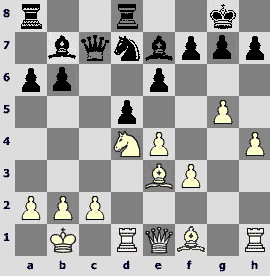
White lost the first game. He needs to win, but the position is not favorable to this. White alters the position radically by a pawn sacrifice.
21.e5. A new method against the d6-d5 breakthrough in the Sicilian – justget rid of the e5-pawn!
21...¤xe5 22.f4 ¤c4 23.Ґc1 ¦e8 24.h5 e5 25.fxe5 Јxe5 26.Јf2 Ґxg5 27.Ґxg5 Јxg5
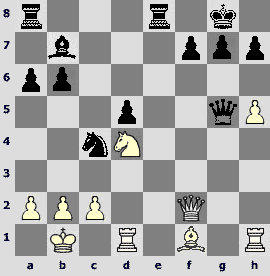
To put it mildly, White's achievements are modest. He lacks two pawns, there is no attack and no winning prospects.
28.¦g1 ¤d2+ 29.ўa1 ¤e4 30.Јh2 Јe5 31.Јg2 h6 32.Ґd3 ¤g5µ. There's such a feeling that a bad bishop on b7 represents some kind of compensation. However, I think that the question is whether White will be able to survive or not.
33.c3 ¦ad8 34.a3 b5 35.Ґb1
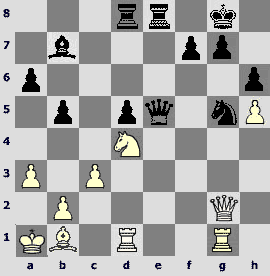
35...¦d6? Striving for active play plays the mischief on Black – he miscalculates. I think that any solid move would be better.
36.¦de1 ¤e4. 36...Јxe1 37.¦xe1 ¦xe1 38.Јg3! This double attack seems to cause Evgeny's defeat in many respects.
37.¤f5! Unfortunately for Black White has another "pack". 37...g5 38.hxg6 ¦xg6 39.¤xh6+ ўg7 40.Јf3 Јf6 41.¤f5+ ўf8 42.¦gf1©
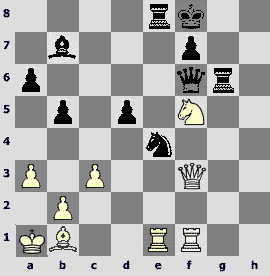
White's position is still not won, but now he has such good chances as never before. The absence of direct threats for the time being is the most disgusting thing in such positions for the defending player.
S.K. I think it's not a tragedy for Black – see move 43.
42...Ґc8 43.Ґxe4 ¦xe4S.K. Maybe the move order is not exact? Let's try 43...dxe4 44.¦xe4 Ґxf5 (44...Јxf5 45.¦f4!) 45.¦xe8+ (45.¦f4 ¦g5! …46.¦xf5 ¦xf5 47.Јxf5 ¦e1+°) 45...ўxe8, and I at least do not see anything better than exchanging everything and transposing into the rook ending, in which it won't be Black to fight for a draw.
44.¦xe4 dxe4 45.Јxe4. S.K. The queens are kept, as well as White's attack.
45...Ґxf5 46.¦xf5 Јe6 47.Јa8+ ўg7 48.¦f1
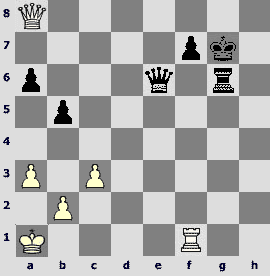
N.V. The position simplified. However, White has enough firepower to complicate Black's king's life. White had won this position gradually. We'll also notice that Black did not have to resign in the end – Shipov gave a study-like idea that had been at Black's disposal.
48...Јc6 49.Јa7 Јd5 50.Јf2 ¦h6 51.Јg3+ ¦g6 52.Јh4 Јc4 53.Јh1 a5 54.Јh3 Јc5 55.Јf3 Јc4 56.Јf5 b4 57.cxb4 axb4 58.Јe5+ ўh7 59.¦h1+ ¦h6 60.Јf5+ ўg7 61.Јg5+ ¦g6
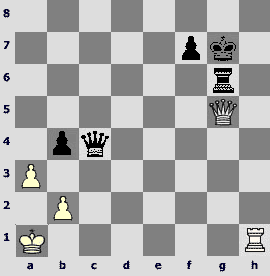
62.Јe5+ 1–0.S.K. Nikita expressed his opinion even more clear-cutthan the author of the brilliant stalemate idea. Because it turns out that if one moves here and there in the position, and White does not come upon the stalemate, Black will still have difficulties.62.Јe5+ ¦f6 63.¦g1+ ўh7! 64.Јh5+! (64.Јxf6 Јa2+!! 65.ўxa2 b3+!!
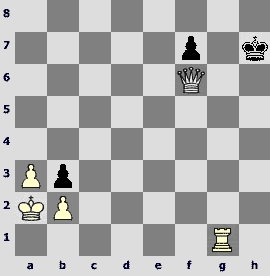
with a stalemate) 64...¦h6 65.Јg5 ¦g6 (Black's moves are strictly forced) 66.¦h1+ ўg7 67.Јd8 ¦g4 (there was a danger of mate, after all)68.Јh8+ ўg6 69.¦h6+ ўf5 70.Јf6+ ўe4 71.¦h1
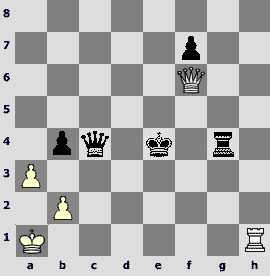
I'm afraid nothing can be done with such a king. In short, it was worthy trying to "catch" the opponent in any case, though one needs to see the stalemate himselfL.
R. Felgaer (2636)– G. Kaidanov (2608)

White's position is just a little bit better. He finds an interesting idea:
17.¦d4. A clear provocation. 17...c5 18.¦h4 Ґf5 19.¦f4

Where does White move? What for should the bishop be brought to its natural place?
19...Ґg6? It was necessary to play 19...Ґe6 20.Ґc2 and the assessment is the same – White's position is a little bit better. S. K. Who would invite a bishop on such a diagonal?
20.e6! A straight nob! Black isknocked down. 20...¦fe8 [20...fxe6? 21.¦xf8+ ¦xf8 22.¤g5!ќ] 21.exf7+ Ґxf7? Unobvious 21...Јxf7! was obligatory (S. K. Nontrivially.) 22.¤e5! Јb7 23.Јxc5 ¤c4 24.Ґxc4 bxc4 White can get an advantage in almost the only sly way:25.b4! cxb3 26.¦b4І.
22.Јxe8+! This resource was evidently missed on the move 19 by Black. White wins a pawn transferring into the endgame.
22...Ґxe8 23.Ґxd5+ Ґf7 24.¦xf7 Јxf7 25.Ґxf7+ ўxf7 26.¤g5+ ўg6 27.h4! We see the chessplayers of different generations playing, and, consequently, their approachesto chess differ as well. White's concrete calculating style is clearly seen in this move.
27...h6? 27...¦d6± was the last chance of continuing the struggle.
28.¦e6+ ўf5 29.¦xa6ќ
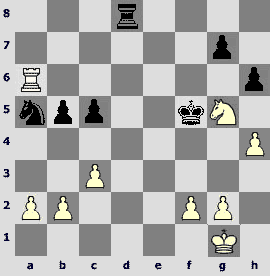
White flew away with a second pawn in the beak. Black's position is hopeless.
29...¤c4 30.¤e6 ¦d7 31.b3 ¤e5 32.f3 h5 33.¤xc5 ¦d1+ 34.ўh2 ¦d2 35.ўg3 ¤g6 36.¤e6 1–0
L. Bruzon (2677) – N. Kabanov (2506) A96
1.c4 f5 2.¤f3 ¤f6 3.g3 d6 4.d4 e6 5.Ґg2 Ґe7 6.0–0 0–0 7.¤c3
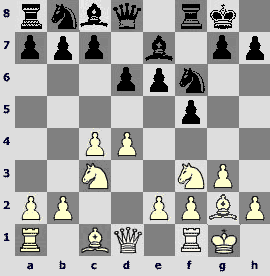
A few following moves of Black especially in combination with the move 10 can practically be examples on the following subject: "How to confuse the opponent, making him feel that your play is beyond any comprehension".
7...a5 8.Јc2 ¤a6 9.a3 ¦b8 10.¦b1

10...c5 S.K. It's clear that he wants to prevent b2-b4, but what for does he have the rook on b8? N.V. Black has no complexes and "heart-searching" at all.
11.¦d1 Јe8 12.Ґg5 Ґd7 13.dxc5 ¤xc5 14.¤d4 Јh5 15.Ґxf6 ¦xf6 16.Ґf3 Јe8. S.K. Master Kabanov plays with a rare composure – he is not confused by the fact that the queen had been on this worthy square a few moves before. N.V. One should, perhaps, always play in this way against a stronger opponent.
17.e3 ўh8 18.Јe2 ¦h6 19.¤db5 e5 20.b4 axb4 21.axb4 ¤a6 22.¤d5 Ґd8
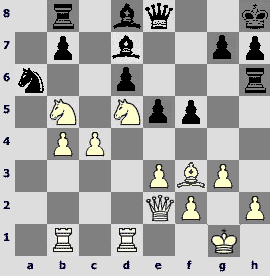
It's worth remembering here that Bruzon had won the first game (this is the second one), and it's sufficient for him to draw to get to the next round. He has the advantage, but the main problem is that the forced actions are desirable.
23.e4. N.V. The move suggested by the co-author is clearly stronger than the text: 23.¤bc3!?
23...fxe4 24.Ґxe4 Ґxb5 25.cxb5 ¤c7 26.¤xc7 Ґxc7
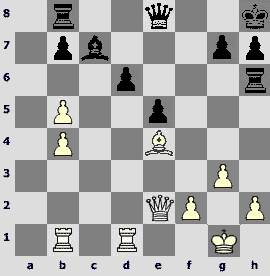
S.K. It turns out that White's position became worse in a moment – Black simply does not have any reachable weaknesses, in addition there is a possibility of psychological attack on the kingside.
27.f3 Ґb6+ 28.ўh1 Ґd4 29.Ґd5 Јd7 30.¦bc1 ¦f8 31.¦c2 ¦g6 32.¦dc1 Ґb6 33.Јc4 ¦gf6 34.Ґe4
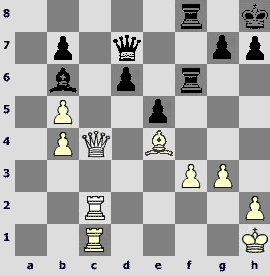
34...g5. Here it comes and, moreover, comes during the time pressure.
35.Јd5.35.Јd3!? was better,too keep f1 under control.
35...g4 36.¦c3 [36.fxg4 Јxg4 37.Јd3] 36...¦8f7 37.¦d3 ўg7 38.¦cd1 Јc8. Absolutely correct psychological move. Black takes the queen away from the d-file just to be on the safe side. And White misused his waiting move.

39.Јb3? gxf3 40.¦xf3 Јg4 0–1 –the material is lost.
Cao Sang (2488) – Volokitin (2666) B30
The next game is a bright example of a "ragged" play in the knock out, when a favourite is obviously stronger and he tears between a calm play for equality and a desire of defeating the opponent.
1.e4 c5 2.¤c3 e6 3.¤f3 ¤c6 4.Ґb5 ¤d4 5.Ґd3 ¤e7 6.0–0 ¤ec6 7.b3 Ґe7 8.¤xd4 cxd4 9.¤e2 d5 10.Ґb2 0–0

It's clear that White did not pose any tangible problems for Black in the opening.
11.¦e1 e5 12.c3 dxe4 13.Ґxe4 dxc3. Obvious unevenness is felt in Andrey's play – pretentious e5 goes badly with a modest dc3 and a further queens exchange.
14.dxc3 Јxd1 15.¦axd1 Ґe6 16.c4І
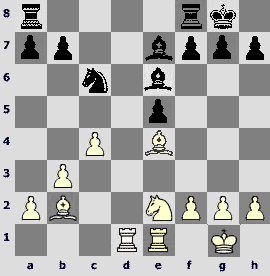
White had already got a clear advantage on the sly.
16...Ґb4 17.Ґc3 a5 18.Ґxc6 bxc6 19.Ґxb4 axb4 20.¤c1 ¦fd8. The Ukrainian does not manage to rearrange his pieces and take on the stubborn defense. White would have to make a great effort to win after 20...Ґf5 21.¦xe5 ¦fd8 22.¦de1 g6І.
21.¤d3 ¦dc8 22.¤xb4 c5 23.¤d3±

What's to be said here? Having lost this hopeless ending, Volokitin did not manage to win the second game – this is how the World Cup has lost one of its most bright participants (1-0).
C.Balogh (2567) – S.Karjakin (2658) (rapid)

This is the fragment of the game of the Hungarian chess player we praised. Having played the opening without any claims, White gets the advantage that is provided by the strong knight on e5 on the 20th move. But one did not have to lose in two moves.
20...¤f5 21.g4 ¤d6? After 21...¤h4 White excluded the knight by 22.Ґg3±, but it seems to be the lesser of two evils.
22.¤xf7! A right hook! 22...¦xe2 23.¤xd8 ¦xe1+ 24.ўf2 ¦e8 [24...¦a1!? 25.¤xc6 bxc6 26.Ґxd6 ¦xa2 27.Ґa3 ¦a1 28.Јa6ќ] 25.¤xc6 bxc6 26.Ґxd6
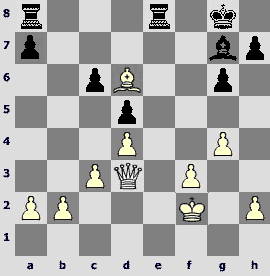
The results of White's blow are obvious: the queen with pawns is stronger in this case than two rooks that lack open files.
26...¦e6 27.Ґf4 ¦f8 28.Ґd2 Ґf6 29.b4 Ґh4+ 30.ўg2 ¦fe8 31.ўf1 ¦b8 32.a4 Ґe7 33.Ґf4 ¦f8 34.Ґe5 Ґf6 35.Јe3ќ
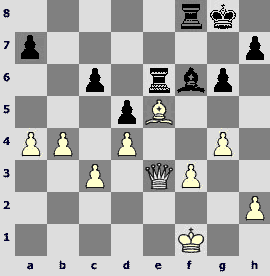
We will omit the rest of the game: Black marked time in his camp for a while (as he had nothing else to do) and resigned (1–0).
A.Khalifman (2653) – E.Inarkiev (2577) E99 (rapid)
S.K. This game is not less important than the encounter of these opponents considered in the first part of the review. Alexander Valeryevich prepared an improvement and moved the knights to the opponent's camp without making any sacrifices. Afterwards it turned out that Black's attack is more serious than knights' maneuvers. One cannot easily suggest obvious improvement for White. It seems that the time-consuming analysis of the middlegame is necessary as in any correction of assessment.
1.¤f3 ¤f6 2.c4 g6 3.¤c3 Ґg7 4.e4 d6 5.d4 0–0 6.Ґe2 e5 7.0–0 ¤c6 8.d5 ¤e7 9.¤e1 ¤d7 10.Ґe3 f5 11.f3 f4 12.Ґf2 g5 13.¦c1 a6 14.¤d3 b6 15.b4 ¦f6 16.c5 ¦h6 17.cxd6. In the classical game of these very opponents there was 17.¤a4 Јe8 18.ўh1 – see the first part of the review. In the rapid Khalifman decided to play in a different way on both queen- and kingside.
17...cxd6 18.g4 fxg3 19.hxg3 ¤g6 20.ўg2 ¤f6
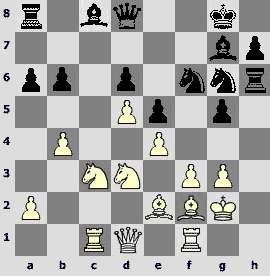
21.¦h1 ¦xh1 22.Јxh1 Ґd7. 22...g4 23.¤a4 b5 24.¤b6 does not suit Black – one has nothing to do in the King's Indian without the light-squared bishop.
23.b5 axb5 24.¤b4. White pieces begin to arrive. To tell the truth, it does not make the events clearer, because there are too many open files.
24...g4 25.¤c6 Јf8 26.¦c2. It is done for knight to capture on b5. 26...h5 27.Јd1 Ґh6 28.¤xb5 h4 29.¤c7. One has to consider 29.gxh4 ¤f4+ 30.ўh2, to eat the pawn and hide the king behind it. However, one does not want to cede f4.
29...hxg3 30.Ґxg3 ¦a3 31.¤e6
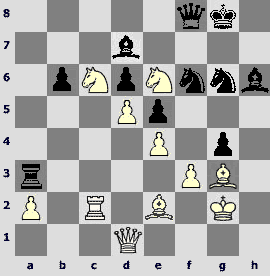
31...Јf7. The proposal of our editor A.Kentler is interesting – 31...Јa8, to attack on a2 and make the queen enter the game; but 31...Ґxe6! 32.dxe6 Ґf4, which we did not consider at that time, seems to be a dangerous strike. Although I has just written about the usefulness of light squared bishop, it turns out one could part with it here. 33.e7 (33.Ґf2 Јh6 – Black threatens with two checks, so one cannot play 34.Јh1 gxf3+ 35.Ґxf3 Јxh1+ 36.ўxh1 ¦xf3°; 33.Ґxf4 ¤xf4+ 34.ўf2 ¤xe2 35.Јxe2 gxf3 – Black has great advantage) 33...Јh6 34.Ґxf4 ¤xf4+ 35.ўg1 Јh3 36.Ґc4+ ўg7° - after the capture on f3 theresistance would be short.
32.Јh1? S.K. It is the mistake that leads to the lost position, but it is not that easy to suggest an active move for White. N.V. There was no need in an active move, there was a need in a solid move.
32...gxf3+ 33.Ґxf3 ¤xd5!
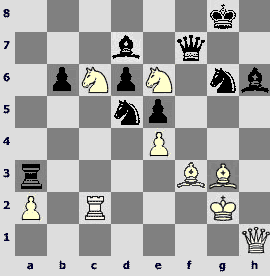
Here, to tell the truth, during the online broadcasting we all on e3e5 site decided that the game would end soon. Another annoying thing (and you can easily guess whom we rooted for in St Petersburg) was that Khalifman had about 18 minutes left against 3-5 Inarkiev's minutes. And there was no way to continue the resistance: White had a hanging f3-bishop, rook, both knights, and the capture of the bishop on h6 could bring nothing to him. We switched to the other game (the game of Sutovsky, if I am not mistaken), and when we were back... Khalifman lacked only two pawns, there was no mate around, so he had changes if we bear in mind the tournament's format.
N.V. It is a key moment of the whole match. Alexander Valeryevich blundered a simple blow; the position was ruined in a second. And the stubbornness of the ex-world champion and his cold-bloodiness attracted the fortune to his side.
34.¦f2 Ґxc6. It seems that 34...¤e3+ 35.ўg1 Јxe6 36.Јxh6 Ґxc6 37.Ґh5 was the most accurate choice – one can get frightened, but ... 37...¤g4, and there is no piece, and no chances to escape. However, it all had to be calculated. N.V. Try to calculate in a time trouble!
35.Јxh6 Јxe6 36.exd5 Ґxd5 37.Ґxd5 Јxd5+ 38.ўh2
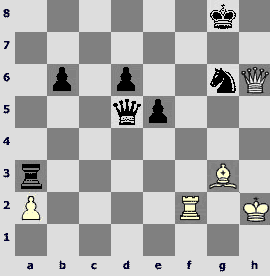
S.K. The assessment of position has not changed, but the opponents at least have the equal number of pieces! White is still in the game. N.V. I do not want to boast, but somewhere here it became clear to me that Khalifman will escape.
38...Јe6 39.Јd2 ¦a7 40.Јg5 (there is a threat of the check from d8) 40...ўg7. Maybe, one had to decide on the pawns exchange: 40...¦xa2 41.Јd8+ ўg7 – White will capture on b6, but the ending should be lost anyway. N.V. Naturally, one had to do it: it is better to exchange the b6-pawn than to lose it.
41.Јd8 ¦f7 42.Јxb6 ¦xf2+ 43.Јxf2
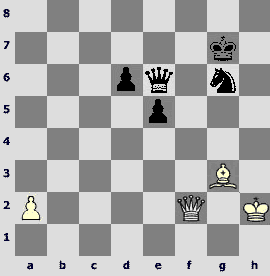
S.K. From this moment the permanent improvement of Khalifman's position begins. He managed to regaina pawn, and now the pawn will move forward. N.V. And from my point of view, the permanent improvement has begun from the ¦f2 move.
43...d5 44.a4 d4 45.a5 d3 46.Јe3 e4 47.a6 Јa2+ 48.ўh3 Јe6+ 49.ўh2 Јa2+ 50.ўh3 d2 51.Јd4+ ўf7 52.a7
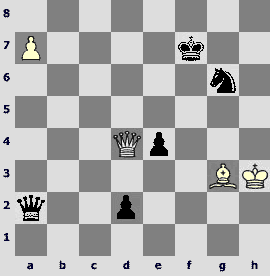
Now it is not clear, how Black should win. N.V. I hope he will not lose because of being nervous...
52...e3 53.Јd7+ ¤e7 54.Ґh4 d1Ј 55.Јxe7+ ўg6 56.Јf6+ ўh7 57.Јe7+ ўg6 58.Јf6+ ўh7 59.Јe7+ ўg8 60.Јe8+ ўg7 61.Јe7+ ўg6 62.Јf6+
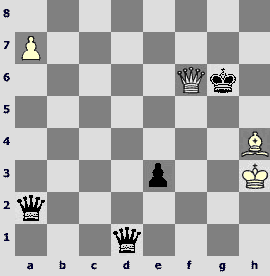
It is a draw! 1/2-1/2
B.Jobava (2601) – A.Beliavsky (2631) E13 (rapid)
1.d4 ¤f6 2.¤f3 e6 3.c4 b6 4.Ґg5 Ґb7 5.¤c3 Ґb4 6.¤d2 h6 7.Ґh4 0–0 8.e4 8...g5 9.Ґg3 Ґxe4 10.h4 Ґg6 11.hxg5 hxg5 12.Јf3 ¤c6 13.Ґxc7 Јe7

All the moves, which have led to this mad position, are well-known in theory, so they were not annotated. Baadur has prepared another "bomb" in the variation. The prize is 3000 dollars (the difference between the first round and the second round) and an opportunity to improve this result later (and he did it by passing safely to the round 3).
14.a3N [14.Ґd3 ¤xd4 15.Јh3 ¤h7 16.Ґxg6 fxg6 17.Јd3 Јg7 18.0–0–0 ¦ac8 19.¤de4 Ґxc3 20.¤xc3 ¦xc7 21.Јxd4 ¦f4і Wells-Eljanov, Amsterdam 2005.
14...¤xd4. Black was defeated, responding to Whiteæs novelty in a principled and logical way. It seems that one should look for the improvement before the 13th move. Or one can consider clumsy 14...Ґxc3 here.
15.Јh3 ¤h7. 15...¤c2+ would have been just the transposition of moves: 16.ўd1 ¤h7 17.Ґd3 ¤xa1, and we have the position in the game. 18.axb4.
16.axb4 ¤c2+ 17.ўd1 ¤xa1 18.Ґd3. White has an excellent position from practical point of view. The a1-knight is not long for this world, and White's attack only starts to burn properly.
18...f5 [18...g4 19.Јxg4 Јg5 20.Јxg5 ¤xg5 21.Ґe5 ¤h7 (21...f6 22.Ґxg6 fxe5 23.ўe2±) 22.¤ce4!±] 19.Јh6 ¦f6 20.Ґe5 ¦af8?. 20...a5 21.¤a4 d6 22.Ґxf6 Јxf6 was stronger, but here also Black hardly risks to win. (Let me remind you that after the defeat in the first rapid game, Beliavsky needed a victory in the second one).
21.g4 Јxb4?! It was a desperate attempt to confuse the young opponent. The move is objectively bad, but it is correct from the sporting point of view. 21...d6 22.Ґxf6 Јxf6 23.ўc1±.
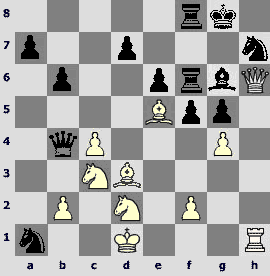
22.f4!ќ. It is a nice move. Bayonet attack of White's infantry is surprisingly beautiful.
22...gxf4 23.g5 ўf7 24.gxf6 ¦g8 25.¤b5 ¤xf6. White's position is won. Baadur wins in one of numerous ways.
26.Јh4 ¤e8 27.¤f3 a6 28.Ґc3
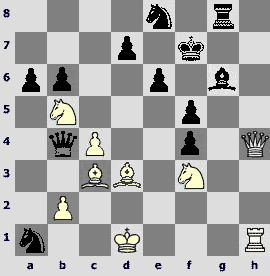
Freeing the e5-square for the knight with tempo.
28...Јa4+ 29.ўe2 axb5 30.¤e5+ ўf8 31.¤xd7+. It is not pawn-grabbing - the d7-pawn prevented the knight from moving to c6.
31...ўf7 32.¤e5+ ўf8 33.¤c6. A mate is inevitable, Black resigned. 1–0
Digest
"There is a ritual number of matches at the start, 64. Of course one cannot annotate them seriously within a short period of time. And what is it for? From my point of view, there is no use to go into nuances of one game and lose sight of other 63. There is only one correct decision, to make a collection of interesting fragments of different games. I will emphasize spectacular moments and crucial mistakes".
Sergei Shipov. World Chess Cup. First Circle.
D.Navara (2646) – P.Nikolic (2584) C91
1.e4 e5 2.¤f3 ¤c6 3.Ґb5 a6 4.Ґa4 ¤f6 5.0–0 Ґe7 6.¦e1 b5 7.Ґb3 d6 8.c3 0–0 9.d4 Ґg4 10.Ґe3 Ґh5 11.h3 Ґg6 12.¤bd2 exd4. It seems that the refutation of the 12...¤xe4 capture is demonstrated in the old game Gulko-Romanishin, Reggio-Emilia1991: 13.Ґd5 ¤xd2 14.Ґxd2 (14.Јxd2; 14.¤xd2 exd4 15.cxd4 ¤b4 16.Ґxa8 Јxa8 – it is a normal compensation for the exchange) 14...Јd7 15.dxe5 dxe5 16.Ґxc6 Јxc6 17.¤xe5 Јd6 18.Ґf4 Јf6 19.Ґg3 – Black lost the c7-pawn and the game.
13.¤xd4 [13.cxd4 ¤b4 14.Јe2 c5 15.a3 ¤c6 16.¦ac1 c4 17.d5 ¤e5 18.Ґc2 ¤xf3+ 19.Јxf3 ¤d7 Dominguez-Morozevich, Calvia 2004] 13...¤xd4. One has to pay attention to the Movsesian-Vescovi game, Bermuda 2004: 13...¤a5 14.Ґc2 c5 15.¤f5 Ґxf5 16.exf5 d5 17.Јf3 h6 18.g4 ¦e8 19.¦ad1 Јc7 20.h4 d4 21.Ґf4 Ґd6 22.Ґxd6 Јxd6 23.g5 ¦xe1+ 24.¦xe1 ¦e8 25.¦xe8+ ¤xe8›.
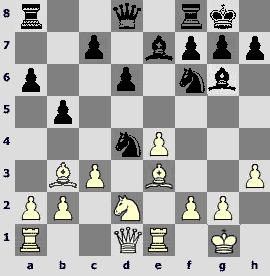
14.Ґxd4 c5?!. 14...d5 15.exd5± does not work, but maybe one should refrain from defining the position 14...¦e8!?. Alexander Morozevich in the game with Timofeev (Moscow 2004) preferred 14...¤h5 15.Ґd5 ¦c8 16.Ґb7 ¦b8 17.Ґc6 ¤f4 18.¤f3 Ґh5 19.Ґa7 ¦c8 20.Ґe3 Ґxf3 21.gxf3 Ґg5 22.ўh2 ¤g6 and got a good play.
15.Ґxf6 Ґxf6 16.Ґd5 ¦b8 17.f4
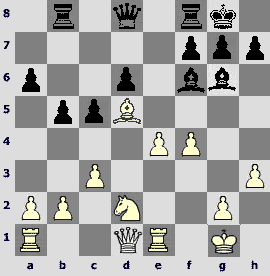
Although White has yet to break through, such position with the bishop on g6 with the d5-square being weak, looks extremely doubtful for Black.
17...h6 18.a4 b4 19.Јf3 ўh8 [19...bxc3!? 20.bxc3 Јa5] 20.¤c4 Јc7 21.ўh1 a5 22.g3. Black has obvious problems with counterplay.
22...Ґh7 23.¦e3 Ґg8
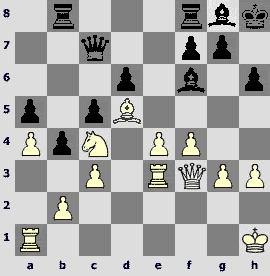
S.K. Black puts the bishop into the game from g6 in a very original way.
24.¦d3 ¦fd8 25.g4 Ґe7. Unbiased computer suggests Black to strengthen himself by 25...Ґh7 26.¦g1 Ґg6 – we have already seen this position of bishop somewhere.
26.g5 Ґf8 27.h4
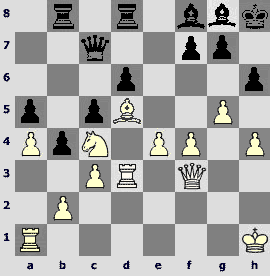
27...bxc3 28.bxc3 ¦b3. It is the result of despair. 29.¤xa5 ¦xc3 30.¦xc3 Јxa5 31.¦g1 Јxa4 32.gxh6 gxh6 33.Јg2 Ґh7 34.¦g3 Ґe7 35.¦g7 1–0
S.K. Generally speaking, the ending with opposite-colored bishops is very popular in the tournament, especially the Sveshnikov version of it. It can be even compared to the former popularity of the Petroff defense: several years ago knock-out fighters tried to end in a draw in the symmetrical position, and now they try to do it in a different structure with strong draw tendencies. To tell the truth, they do not manage to do it.
N.V. They do not manage at all.
S.Kudrin (2551) – P.Eljanov (2663) B33
1.e4 c5 2.¤f3 ¤c6 3.d4 cxd4 4.¤xd4 ¤f6 5.¤c3 e5 6.¤db5 d6 7.Ґg5 a6 8.¤a3 b5 9.¤d5 Ґe7 10.Ґxf6 Ґxf6 11.c3 0–0 12.¤c2 ¦b8 13.h4 Ґe7 14.¤ce3 Ґe6 15.Јf3 Јd7 16.¦d1 Ґd8
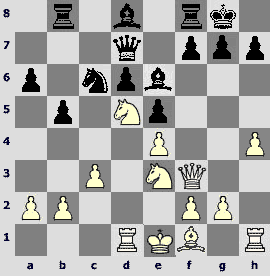
17.Ґe2. Before the start of the World Chess Cup the main discussion concerned 17.Ґd3 ¤e7 18.Ґc2 b4. For example, it was the way Karjakin played against this very Eljanov in Warsaw in the European Championship this year. It seems that the refutation was found in this variation, and Kudrin tries to change the subject.
17...¤e7 18.h5 One does not want to make this move, because now Black can block the kingside on the g5-square (previously White played only 18.g4): 18...h6 19.0–0 Ґb6 20.¤f5 Ґxf5 21.exf5 ¤xd5 22.¦xd5 Јe7
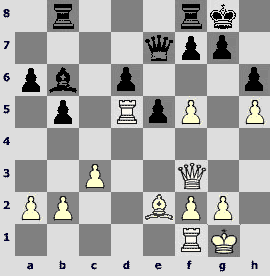
S.K. I am sure the position can be held, especially as it is not the first time Eljanov plays this structure. However, he did not manage to make a draw, having won in the first game.
23.Ґd3 ¦fd8 24.¦d1 ¦bc8 25.Ґe4 ¦c4 26.¦e1 ¦c5 27.a3 a5 28.b4 axb4 29.axb4 ¦xd5 30.Ґxd5 ¦c8 31.¦a1 Јg5 [31...Јf6 32.¦a6 ¦b8 33.Јd3ѓ] 32.g3. Already here there was the 32.Ґxf7+ strike, realized subsequently in the game, and if 32...ўxf7 33.Јb7+ ¦c7, then 34.Јd5+! with a mate on the 8th rank. It can be easily blundered of course (34.Јxb6 ¦xc3 35.Јxb5 is bearable for Black).
32...e4. S.K. I want to see clear play. N.V. Everybody wants something. My co-author wants clear play, White wants a victory, Black wants a draw...
33.Ґxe4 Јf6 34.¦a3 Јe5 35.ўg2, and here Black blunders on f7 for the second time:
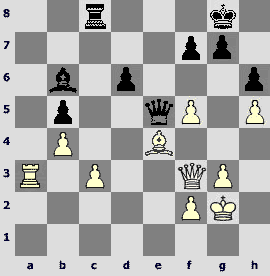
35...Ґd8 36.Ґd5 Ґf6 37.Ґxf7+ќ ўh8 [37...ўxf7 38.Јb7+ќ] 38.¦a8 ¦d8 39.Јc6 Јe7 40.Ґe6 Јf8 41.¦xd8 Јxd8 42.Јxb5 Ґxc3 43.Јc4 Ґd2 44.Јd4 Ґg5 45.b5 Јb8 46.Ґc4 Ґd8 47.Јe4 Ґb6 48.Јe7 Ґd4 49.Ґd5 ўh7 50.Јf7 Јd8 51.b6 1–0
S.Ganguly (2562) – H.Nakamura (2662) B92
1.e4 c5 2.¤f3 d6 3.d4 cxd4 4.¤xd4 ¤f6 5.¤c3 a6 6.Ґe2 e5 7.¤b3 Ґe7 8.Ґg5 ¤bd7 9.a4 b6 10.Ґc4 Ґb7 11.Јe2 0–0 12.0–0 Јc7 13.¦fd1 ¦fc8 14.¤d2 h6 15.Ґxf6 ¤xf6 16.Ґb3 Ґc6 17.¤f1 Јb7 18.¤d5 b5 19.axb5 Ґxb5 20.Јf3
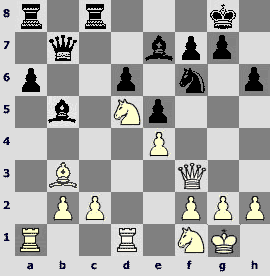
Everybody knows that Nakamura is an original player, but his next move is amazingly cynical, at least for me!
20...Ґxf1 21.ўxf1 a5 22.Јe2 ¤e8 23.¦d3 Ґd8 24.¦f3

White has nothing to improve, everything stands on its best spots already.
24...a4 25.¦xa4 ¦xa4 26.Ґxa4 Јxb2 27.Јd1 ¤f6 28.Ґb3 Јd4. It is not nice to capture on e4: 28...¤xe4 29.¦xf7! ўxf7 30.Јf3+ ¤f6 31.¤xf6+ ўg6 32.Јg4+ ўxf6 33.Јxc8±.
29.¦d3 Јxe4 30.¤xf6+ Ґxf6 31.¦xd6
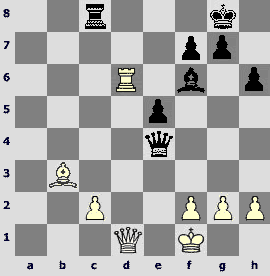
Despite the simplifications, which Black managed to cause, he still has to defend from the attack on f7. Besides, now a rook and bishop ending can be played, because White has a passed pawn.
31...Ґe7. One cannot defend the 7th rank by 31...¦c7 because of 32.¦xf6ќ, but 31...Јf4 deserves attention, to enable ¦c7 – 32.¦d7 Јxh2 33.Јg4 (33.¦xf7 Јh1+) 33...ўh8 34.¦xf7І.
32.¦d7 ўf8 33.¦d3 [it is better to play 33.Јh5 immediately] 33...Ґf6 34.¦d7 Ґe7 35.Јh5 Јf4 36.g3 Јf6 37.¦d3 ¦c7 38.ўg1 [38.¦f3 Јa6+ and Ґf6] 38...e4 39.¦d5 e3 [39...g5 40.Јg4ѓ and ¦f5] 40.fxe3±
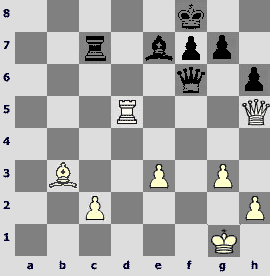
Now White has a material advantage.
40...Јb6 41.ўf2 Ґg5 42.Јf3 g6 43.h4 Ґf6 44.h5 g5 45.ўg2 ўg7 46.¦d3 ¦e7 47.e4 Ґe5 48.Јf5 Јf6 49.Јc8 ¦c7 50.Јe8 Јe7 51.Јb5 Ґf6 52.Јf5 Јe5 53.¦d5 Јxf5 54.¦xf5, and Nakamura did not manage to hold the position, which is not surprising at all (1–0).
A.Timofeev (2658) – E.Agrest (2571) B92 (rapid)
1.e4 c5 2.¤f3 d6 3.d4 ¤f6 4.¤c3 cxd4 5.¤xd4 a6 6.Ґe2 e5 7.¤b3 Ґe7 8.0–0 0–0 9.a4 b6 10.Ґg5 ¤bd7 11.Ґc4 Ґb7 12.Јe2 Јc7 13.¦fd1 ¦fc8 14.¤d2 h6 15.Ґxf6 ¤xf6 16.Ґb3 Ґc6 17.¤f1 ¦ab8. This variation is the same to the one in the Ganguly-Nakamura game. Nakamura played 17...Јb7, as everyone before him as Black, and the game continued 18.¤d5 b5 19.axb5 Ґxb5 20.Јf3 Ґxf1 21.ўxf1І.
18.¤g3 b5 19.axb5 axb5 20.¤h5 b4 21.¤xf6+ Ґxf6 22.¤d5 Ґxd5 23.¦xd5
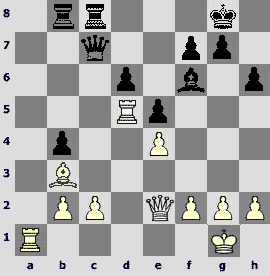
23...¦a8 24.¦ad1 Ґe7 25.Јh5 Ґf8 26.¦5d3

S.K. And Black stands bad again; it is the same f7-square. N.V. It is asoft spot in positions of this sort.
26...¦a7 [26...ўh7 27.Ґxf7 Јxc2 28.Јg6+ ўh8 29.Ґb3 with destruction on the light squares] 27.¦f3 ¦ca8 28.g3 Јe7 29.¦xf7 Јxf7 30.Ґxf7+ ¦xf7 31.Јe2ќ, and White wins. He did it with amazing ease, didn't he? (1–0)
D.Sadvakasov (2612) – G.Milos (2620)

N.V. It is a very interesting moment. The Brazilian loses the ending from the legendary Kramnik-Svidler game, where the Petersburger resigned in a drawn position. The difference from that game was minimal: one has to put two pawns on g5 and h3, and White' s pawn is already standing on c4. But it does not change the matter.
48...ўb6? S.Shipov showed the right plan. One just has to stand still! The bishop holds the a7-g1 diagonal, the king does not let the colleague into his camp. с7, d6, e5, f4 are the key squares for that.
49.ўc4ќ. I think one cannot hold the position already. That is how one can drop out from the tournament in one move...
49...ўa5 50.ўb3 Ґh4 51.Ґb5 Ґe7 52.ўc4 Ґf8 53.ўd5 Ґe7 54.Ґe8 Ґf8 55.Ґb5 Ґe7 56.c4 ўb4 57.Ґd7 Ґf8 58.Ґb5 Ґe7 59.ўc6 Ґf8

60.c5! Ґe7 61.Ґd3 Ґf8 62.ўd5 Ґxc5 63.a5. The pawn queens. It is high time for capitulation.
63...Ґf2 64.a6 ўc3 65.Ґg6 Ґa7 66.ўc6 ўd4 67.ўb7 Ґc5 68.a7 Ґxa7 69.ўxa7 ўe5 70.ўb6 ўf6 71.Ґh5 ўg7 72.ўc5 ўf6 73.ўd6 ўg7 74.ўe7 ўh7 75.ўf7 ўh8 76.ўg6 1–0
W.Kobese (2400) – B.Gelfand (2717) B87
S.K. The strengths of the players in the round 1 are often unequal. The main reason is the geographical principle of choosing the tournament participants. N.V. The inequality is always present in the world: it is warm in Africa, the motherland of the white pieces' leader, and it is cold in Khanty Mansiysk...
1.e4 c5 2.¤f3 d6 3.d4 cxd4 4.¤xd4 ¤f6 5.¤c3 a6 6.Ґc4 e6 7.Ґb3 b5 8.Ґe3 Ґb7 9.f4 ¤bd7 10.0–0 Ґe7
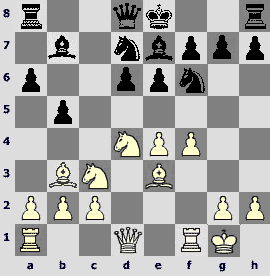
11.Ґxe6?! S.K. This sacrifice tempts many chess players over 2400, but it is doubtful. N.V. It is an attempt to get one chance out of thousand. But on the other hand, If White has to win back, he should do it with a bang.
11...fxe6 12.¤xe6 Јc8 13.¤xg7+ ўf7 14.¤f5

14...Ґf8. It looks elegant: Black loses a tempo and puts the rook on the open g-file, but unfortunately this maneuver has several predecessors.
15.e5
15.¤xd6+ Ґxd6 16.Јxd6 ¤xe4 17.¤xe4 Ґxe4 18.¦ad1 ¦d8 19.c3 ¤f6і Voekler-Enders, Germany 1992; Maybe, 15.Ґd4 ¦g8 16.¤d5 Ґxd5 17.exd5 Јb7 18.¤e3 ¦e8 19.b3 ¦g6 20.c4 ўg8 21.¦c1 ¦e4 22.¤f5 ¤xd5! 23.cxd5 Јxd5µ is more stubborn than other choices. Bragin-Magerramov, Podolsk 1992.
15...¦g8 16.¤g3. The position is absolutely hopeless for White: 16.¦f2 dxe5 (16...¤g4!? 17.¤xd6+ Ґxd6 18.Јxd6 ¦g6°) 17.fxe5 Јc6 (17...¤xe5µ) 18.¤g3 ¤xe5 19.Јh5+ ¦g6 20.Јxe5 ¦e8 21.Јd4 ¦xe3 22.Јxe3 Ґc5› Borkowski-Ross, Saint John 1988.
16...Јc6 17.Јe2 ¦e8° 18.¦ad1 [18.exf6 ¦xe3 19.Јh5+ ¦g6 20.Јxh7+ Ґg7°] 18...dxe5 19.fxe5 ¦xe5 20.Јf2 ¦xe3 21.¦xd7+ Јxd7 22.Јxe3 Јc6 23.¤ge4 ¦g6 24.Јh3 ўg8 25.Јf5 Ґe7 0–1. S.K. It is hard to struggle against an extra piece. N.V. And it is even harder to struggle against an extra piece in Gelfand's hands.
V.Milov (2652) – L.Pantsulaia (2578)
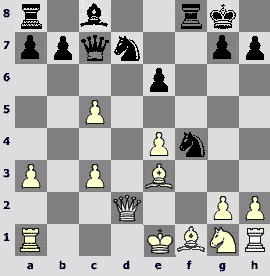
It is a complicated position. White has two bishops and an extra pawn, Black has a harmonious development.
14.Јd6 Јa5 15.¦c1 e5. It opens the way for the c8-bishop in prospect partially. 15...¤g6? 16.¤f3± is very weak.
16.¤f3. It is always pleasant to develop a piece, but 16.c6! bxc6 17.g3 ¤g6 18.Ґc4+ ўh8 19.h4ѓ would have been stronger, and White possesses the initiative in the game at least.
16...¦f6 17.Јe7 Јa4„ 18.¤d2 ¦f7?! It is the time loss. It was more reasonable to make useful 18...ўh8!? move, preventing White from putting the bishop on c4 with a check.
19.Јd8+ ¦f8 20.Јc7 ўh8 21.g3 ¤e6 22.Јd6
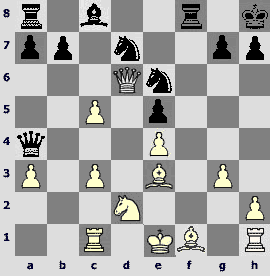
N.V. It is Milov's pirouette. Јd6-e7-d8-c7-d6 (S.K. It is a pity that we cannot paint the arrows on the board like Alexander Grischuk on ChessPro site, Milov's pirouette would have looked very picturesque).
22...¤f6 23.Јd3? it looks as if the queen was White's only fighting unit on the board. One should have remembered about the kingside – 23.Ґe2! ¤xe4 24.Ґd1 ¤xd6 25.Ґxa4 ¤f5 26.Ґf2І.
23...¤g4 24.Ґg1 Јxa3 25.¦b1 ¦d8 26.Јc4 ¤g5 27.Јb3 [27.h3!?] 27...Јa5 28.Ґe2?! In this case the wish to develop the bishop is destructive. But even after 28.h4 Black had a deserving answer: 28...Ґe6 29.Јb4 Јa2 30.¦b2 ¦xd2!!

31.ўxd2 (31.¦xa2 ¤f3#) 31...¤xe4+‚ with strong attack.
28...¤h3. It was a correct positional decision. But the exchange sacrifice was far stronger: 28...¦xd2! 29.ўxd2 ¤xe4+ 30.ўc2 (30.ўe1 ¤xc3°) 30...¤xc5 31.Ґxc5 Јxc5µ. Black gets two pawns for the rook, perfect knight and weak opponent's king.
29.¤c4 Јc7 30.¤d6 ¦f8і. Black gets the advantage. The prospects of the h1-rook are rather unclear; a couple of white knights gives a nice impression.
31.Јd5? White moved the queen 11 times during 31 moves... One had to struggle bitterly after 31.Ґxg4 Ґxg4 32.Ґe3 ¦f3 33.ўd2µ.
31...¤xg1 32.¦xg1

32...Ґe6!µ. It is a simple and logical jab: White had opened completely.
33.¦xb7 Јa5 34.Јd2. 34.¦b5? Јa3 35.Јd2 a6 36.¦b4 Јa1+ 37.Ґd1 ¤f2° is even worse.
34...Јxc5 35.¦f1 ¦fd8 36.Ґxg4 ¦xd6 37.Јg5? It is White's last mistake in the game. However strange it is, he could still resist after 37.Ґxe6 ¦xd2 38.ўxd2µ.
37...Јxc3+° 38.ўf2 ¦f8+ 39.ўg2 Јc2+ 40.ўg1 Јc5+ 41.ўg2 Јc2+ 42.ўg1 ¦xf1+ 43.ўxf1 Ґc4+ 0–1
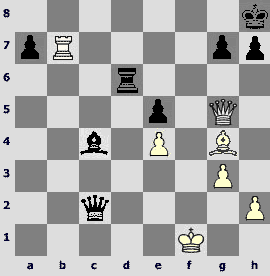
By playing in a risky way, White ran into a counterattack and could not contain the opponent. The final position is revealing: only the g4-bishop occasionally glances at his own king.
A.Ivanov (2589) – J.Granda Zuniga (2637)
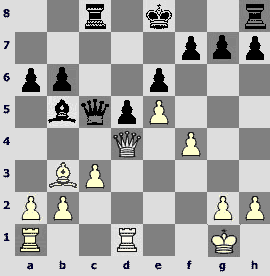
Black gets a rather human version of the French ending. To solve the problem of the light-squared bishop forever, it is transferred to e4. There is nothing to be especially afraid of.
20.a4 Ґe2 21.¦d2 Ґg4 22.Ґc2 g6 23.Јf2 Јxf2+ 24.ўxf2 Ґf5 25.Ґd1 Ґe4 26.Ґe2 a5
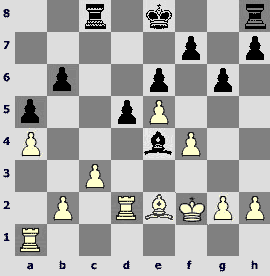
27.g4 ўe7 28.h4 f6 29.exf6+ ўxf6 30.ўe3 e5 31.¦f1 ¦hf8
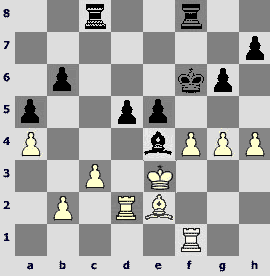
32.Ґa6! S.K. It poses the problems, because White doubles the rooks and invades the f-file. And still one does not have to lose immediately. N.V. It is unpleasant to become the annotator with the only pet remark, but I cannot but write: why should one lose if it is possible not to?
32...exf4+? [32...¦cd8 33.¦df2 ўe6 34.fxe5 ¦xf2 35.¦xf2 ўxe5 36.¦f7 h5І] 33.¦xf4+ ўe5 34.¦xe4+ dxe4 35.Ґxc8 ¦xc8 36.¦d4±, and White wins: 36...h5 37.¦xe4+ ўf6 38.g5+ ўf5 39.¦f4+ ўe5 40.¦e4+ ўf5 41.¦d4 ўe5 42.c4 1–0
No comments
S.K. It is physically impossible to annotate some or even many games of the third playing day.
N.V. I agree with you. The amount of blunders was exceedingly high. We will not give the variations, the participants could see them themselves.
A.Istratescu (2622) – L.Ftachnik (2612) (rapid)
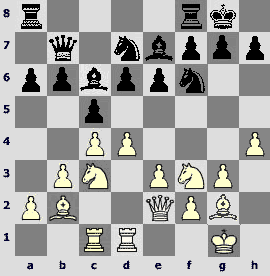
14...¦ae8 15.d5 exd5 16.cxd5 ¤xd5 17.¤xd5 Ґxd5 18.¦xd5 Јxd5 19.¤g5 Јf5 20.Ґe4
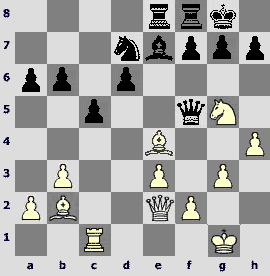
1–0
C. Matamoros Franco (2501) – V.Bologan (2682)
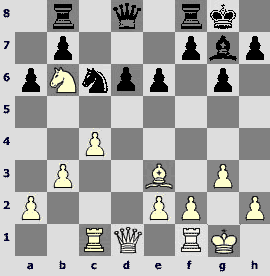
20...¤e7 21.f3 d5 22.cxd5 exd5 23.Ґc5 ¦e8 24.e3 d4 25.Ґxd4 ¤f5 26.Ґxg7 Јxb6 27.Ґd4 Јa5 28.¦f2 ¦bd8 29.¦d2 ¤xd4 30.exd4 h5 31.ўg2 ¦d5
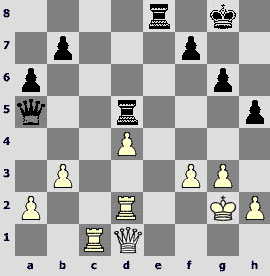
32.¦c5 ¦xc5 33.dxc5 Јxc5 34.¦d8 ¦xd8 35.Јxd8+ ўg7 36.Јd2 b5 37.Јb2+ ўg8 38.b4 Јe3 39.h4 Јe1
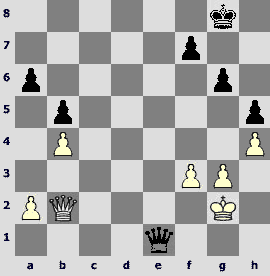
40.f4 Јe4+ 41.ўf2 Јd3 42.Јb3 Јd2+ 43.ўf3 ўg7 44.ўe4 ўf6 45.a3 ўe7 46.Јe3 Јxe3+ 47.ўxe3 ўf6 48.ўe4 ўe6 49.ўd4 ўf5 50.ўc5 ўg4
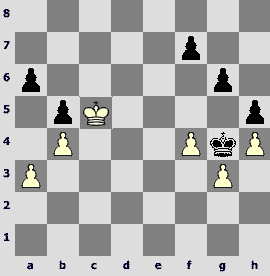
51.ўb6 ўxg3 52.ўxa6 ўxf4 53.ўxb5 g5 54.ўa6 gxh4 55.b5 h3 56.b6 h2 57.b7 h1Ј 58.b8Ј+ ўf5 59.Јc8+ ўf6

60.Јd8+ ўe6 61.Јc8+ ўd6 62.Јf8+ ўe5 63.Јe7+ ўd4 64.Јf6+ ўe3 65.Јe5+ Јe4 66.Јxh5 f5 67.Јh3+ ўd2 68.Јh2+ ўc3 69.ўb5 f4 70.Јh8+ ўb3 71.Јf8 f3 72.Јf7+ ўxa3 73.Јf8+ ўb2 74.Јf6+ ўc2 75.ўa6 Јd5 76.Јf4 ўd3 77.Јg3 Јc4+ 78.ўa7 Јc5+ 79.ўa8 Јd5+ 80.ўa7 ўe2 81.Јg4 ўd3 82.Јg3 Јd4+ 83.ўa6 ўe2 84.Јh3 f2 85.Јh5+ ўe1 86.Јa5+ ўd1 87.Јh5+ ўc2 88.Јe2+ ўc3 89.ўb7 Јg7+
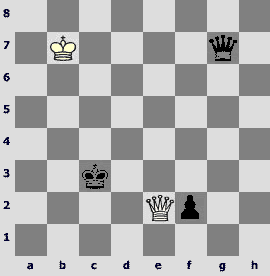
0–1
S.K. When analyzing the next game,one should note that it was played in the variation Sergei Movsesian employs for several years now. N.V. And the game was played with normal control.
M.Paragua (2596) – S.Movsesian (2635) D15
1.d4 ¤f6 2.¤f3 d5 3.c4 c6 4.¤c3 a6 5.c5 ¤bd7 6.Ґf4 ¤h5 7.Ґd2 ¤hf6 8.Ґf4 ¤h5 9.e3 g6 10.h4 ¤xf4 11.exf4 Ґg7 12.h5 b6 13.cxb6 Јxb6 14.Јd2 ¦b8 15.b3 ¤f6 16.hxg6
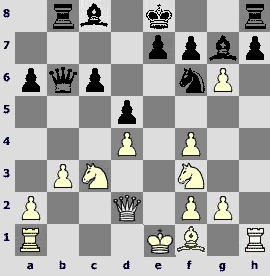
16...fxg6 17.¤e5 ¤g4 18.¤a4 Јc7 19.¦c1 ¤xe5 20.fxe5 0–0 21.Ґd3 Јd7 22.¦h4 e6 23.ўe2+-
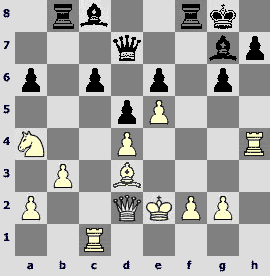
23...Јf7 24.f3 Ґd7 25.¦ch1 h5 26.¦1h3 Ґe8 27.Јg5
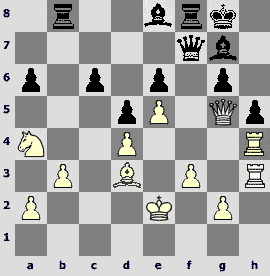
27...c5 28.¤xc5 Ґb5 29.¦g3 Ґxd3+ 30.ўxd3 ўh7 31.¤d7 ¦g8 32.¦gh3 ¦gd8 33.¤f6+ Ґxf6 34.exf6 ¦b7 35.g4 Јe8 36.gxh5
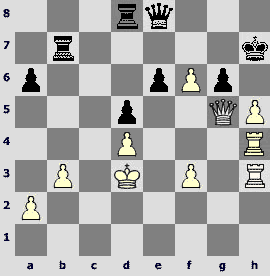
36...¦xb3+ 37.axb3 Јb5+ 38.ўe3 Јxb3+ 39.ўf2 Јc2+ 40.ўg3
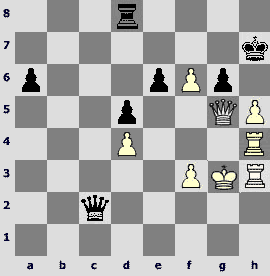
40...Јg2+ 41.ўxg2 1–0
R.Kempinski (2619) – R.Vaganian (2614) (rapid)
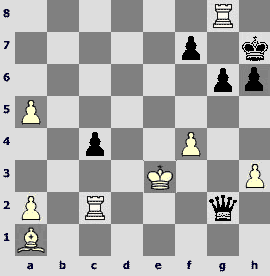
39...ўxg8 1–0
S.K. Especially dangerous events took place in the Erenburg-Izoria match. Zviad constantly outplayed the opponent, but Sergey's stubbornness was rewarded generously. However, it is a sad situation to observe.
N.V. How many years of life has Izoria lost in these three days? Let us hope that this fate strike will just harden him.
S.K. As our trainer in the Pioneers Palace A.M.Yuneev used to say, the main thing is to avoid casualties!
Z.Izoria (2646) – S.Erenburg (2582) (rapid)
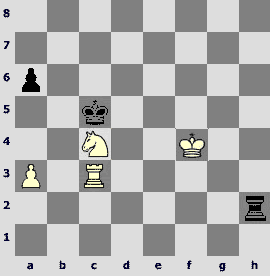
52.ўe4 ¦h4+ Ѕ–Ѕ
S.Erenburg (2582) – Z.Izoria (2646) (blitz)
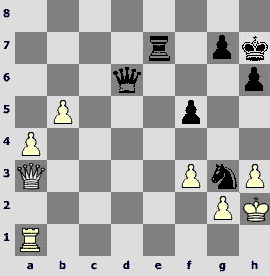
48...¤e2+ 49.Јxd6 1–0
The next game is the seventh and the decisive one. It is enough for Black to make a draw.
Z.Izoria (2646) – S.Erenburg (2582) (blitz)
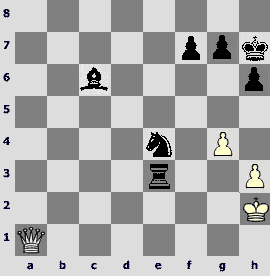
53.Јa6 ¦f3 54.Јxc6 ¦f2+ 55.ўg1 ¦f4 56.Јc7 g5 0–1
